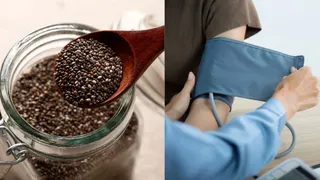- By Dr Sadhana Kala
- Mon, 20 Oct 2025 09:04 PM (IST)
- Source:JND
A nation’s intelligence can be shaped by something as small as a grain of salt.October 21 is Global Iodine Deficiency Disorder (IDD) Day—a reminder that a trace element, missing from our diets, can quietly erode human potential.
Iodine, required in minute quantities, is vital for thyroid hormone production and brain development. However, millions of people in India and around the world still struggle with the absence of iodine, an invisible crisis that is often overlooked.
Why Iodine Matters
“Iodine deficiency remains the world’s leading cause of preventable brain damage.” – World Health Organization
Iodine fuels the thyroid gland, which governs metabolism, growth, and cognitive development. Its deficiency triggers a range of disorders—from goiter and hypothyroidism to stillbirths, mental retardation, and learning disabilities.
For pregnant women and infants, the consequences are profound: even mild iodine deficiency during pregnancy can lower a child’s IQ by 10–15 points.
Though the solution—iodized salt—is inexpensive and straightforward, the problem persists due to uneven access, low awareness, and inconsistent enforcement.
India’s Journey from Goiter Belts to Universal Iodization
The iodized salt movement in India is one of the greatest public health success stories of the 20th century.
Goiter (enlargement of the thyroid gland, a butterfly-shaped gland at the base of the neck) in a girl
In the 1950s, large parts of the Himalayas and the Gangetic plains were known as “goiter belts.” Surveys revealed that up to 30% of the population in some areas had enlarged thyroids due to iodine deficiency.
In response, India launched the National Goitre Control Programme (NGCP) in 1962, which was later expanded into the National Iodine Deficiency Disorders Control Programme (NIDDCP) in 1992. Its mission: ensure that all edible salt is iodized.
With the 2005 ban on non-iodized salt and strong public health advocacy, India achieved remarkable coverage. Today, over 90% of households use adequately iodized salt—a leap from less than 20% in the early 1990s.
The Persistent Pockets of Deficiency
Iodine deficiency is not just a health issue—it’s a human capital issue.
Despite progress, the problem hasn’t vanished. The National Family Health Survey (NFHS-5) reveals that some rural and tribal areas still struggle with poor access to adequately iodized salt.
Research by the Indian Council of Medical Research (ICMR) estimates that one in four Indians remains at risk of iodine deficiency.
Why it persists:
• Poor storage practices—iodine evaporates when salt is kept in humid conditions.
• Local salt production is unregulated, leading to lapses in quality control.
• Cheaper, non-iodized salt in informal markets.
• Low awareness of iodine’s role in brain development.
This nutritional divide reflects more profound inequities—where a child’s geography and income determine their cognitive future.
Hidden Inequality in India’s Nutrition Story
“As food systems industrialize, fortification must move from kitchen salt to the salt in every packaged snack.” – Global Alliance for Improved Nutrition (GAIN)
Urban India faces a new challenge: the rise of processed foods. Many manufacturers utilize industrial-grade, non-iodized salt, which reduces iodine intake, even though households may consume iodized varieties.
Meanwhile, rural families that rely on loose or locally sourced salt often do not check iodine levels, leading to a quiet, uneven return from iodine deficiency.
The Economic Impact of Iodine Deficiency
The cost of inaction is enormous. According to the World Bank and UNICEF, iodine deficiency can reduce national productivity by 10–15% in severely affected regions.
For India, this loss translates into billions of dollars in lost GDP each year. Conversely, every dollar invested in salt iodization yields $30 in economic returns through increased productivity, enhanced intelligence, and lower healthcare costs.
Salt Producers: The Unsung Frontline
“Ensuring every grain of salt is iodized is both a technical and a social challenge.”
India is the world’s third-largest salt producer, with over 12,000 producers—mostly small-scale operations spread across Gujarat, Rajasthan, and Tamil Nadu. Many of these producers lack the resources necessary for consistent iodization.
Partnerships with organizations such as Tata Trusts, GAIN, and the Micronutrient Initiative have improved production standards and raised awareness. However, fragmented supply chains and quality lapses continue to threaten uniform coverage.
Innovation and the Future of IDD Elimination
Science and technology are reshaping India’s strategy:
• Double Fortified Salt (DFS): This product combines iodine and iron to address two significant deficiencies at once. Pilot programs under Poshan Abhiyaan show promise, although scaling up remains costly.
• Digital iodine testing kits: These portable, easy-to-use devices facilitate on-site quality checks.
• Supply-chain traceability: Barcodes and digital monitoring help prevent dilution or mislabeling between the factory and the consumer.
However, technology alone is insufficient. Grassroots education—delivered through Anganwadi centers, schools, and health workers—is essential to ensure that iodized salt becomes a daily habit.
Women, Pregnancy, and the Generational Impact
“When a mother lacks iodine, her child may lose potential that no education can restore.”
Women play a crucial role in the iodine narrative. Their nutritional status during pregnancy and lactation significantly influences their children’s mental development. Iodine deficiency can result in miscarriages, stillbirths, or irreversible brain damage in infants.
Initiatives such as Poshan 2.0 and Anaemia Mukt Bharat integrate iodine awareness, treating maternal health and child intelligence as interconnected issues.
India’s Global Role in Ending IDD
Over 120 countries now enforce salt iodization laws. With its scale and experience, India can set an example by supporting iodine fortification efforts in neighboring regions through trade and technical collaboration.
As the world observes Global IDD Day, India’s success offers lessons in how political will, community outreach, and low-cost innovation can eliminate a disorder that once seemed inevitable.
The Last Mile: From Policy to Plate
“Iodized salt is more than a condiment—it’s cognitive insurance for a nation.”
Iodine deficiency can be eliminated. What remains is implementation at the final mile.
The next phase of action:
• Enforce iodization in all forms of salt, including those used in industrial and food-processing sectors.
• Strengthen quality testing and monitoring at the retail level.
• Support small producers with affordable iodization tools.
• Build awareness campaigns that link iodine with child intelligence and academic success.
Conclusion: The Silent Nutrient that Shapes Nations
Recommended For You
Ending iodine deficiency is one of the few public health goals we can fully achieve—if we don’t let it slip through our fingers.
India’s fight against iodine deficiency stands as a quiet triumph. From the endemic goiter belts of the past to near-universal access to iodized salt, this progress demonstrates that small interventions can lead to significant transformations.
However, vigilance is essential. Unequal access, gaps in the industrial food supply, and public complacency could undermine decades of advancements.
As we recognize Global Iodine Deficiency Disorder Day, the message is unmistakable: within every grain of iodized salt lies the potential for a sharper, healthier, and more equitable India. Ensuring iodine sufficiency goes beyond disease prevention—it is about safeguarding intelligence, dignity, and opportunity for every generation.
(Note: Dr (Prof) Sadhana Kala is a USA-trained robotic & laparoscopic surgeon, Uppsala University, Sweden, trained fertility specialist, Icon Endoscopic Surgeon of North India, and National Icon Endoscopic Surgeon of India. She is rated as India's Best Gynecologist by Google.)
(Disclaimer: The views expressed in this article are the personal opinions of the author.)






